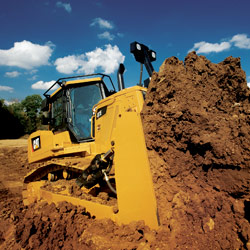
On December 22, 2009, Caterpillar Inc. presented the keys of the first innovative AC electric drive track-type tractor in the industry to long-time customer TJ Lambrecht, an earthmoving contractor headquartered in Joliet, Illinois. The revolutionary electric drive system developed for track-type tractors gives the new D7E an unmatched combination of power, sustainability, control and maneuverability.
iBi spoke with Mike Betz, lead engineer for the D7E, and David Nicoll, North America product manager for medium tractor products, about the D7E’s innovative features and the design process behind the machine.
What makes the D7E tractor so unique? What are some of its major innovations?
Mike Betz: Often, new product introductions mean changes to weight, horsepower or particular features to make incremental improvements to the performance of the machine. The D7E is a whole system approach aimed at achieving quantum leaps in productivity, efficiency and sustainability. At the heart of it is an AC electric drive system that is sealed and liquid-cooled to handle the particular requirements of dozer applications, like constant cycling back and forth.
How long did it take to go from inception to production?
Betz: The research started in the late 1990s.
Describe some of the patents involved throughout the process.
Betz: The D7E is a Cat design with more than 100 patents. Several of the patents are on the controls and configuration—related to applying electric drive to this type of application.
What was the most interesting thing learned by the company as the design process evolved?
Betz: This project really highlighted the value of teamwork in product development. There were many challenges along the way that the development team overcame. This project highlighted how fast our engineers can learn new technologies and apply them to create more customer value. The electric drivetrain team really embraced the new technology, even though it is different from what Caterpillar has been producing for many, many decades.
What role does central Illinois play in the manufacturing supply chain?
David Nicoll: The tractor and the electric drive powertrain are assembled in East Peoria. Some major fabrications for the tractor’s structure are also made in East Peoria.
How challenging was it for suppliers to adapt to the D7E’s new features?
Nicoll: The D7E and its electric drive system are Caterpillar designs that emerged from a very collaborative relationship among many Caterpillar design groups, our dealer and customer input, and Caterpillar suppliers. This is true of all our product development at Caterpillar. However, the D7E was unique in that the product was undergoing a transformational change, and that required all the parties to work together more collaboratively than ever.
What is the expected timeline for ramping down the older D7R model?
Nicoll: Mid-year 2010, the D7R will go out of production for U.S. and European markets with highly regulated engine emissions.
Can parts from older models be remanufactured into working parts for the D7E?
Nicoll: There are some parts that are interchangeable—like some of the undercarriage components, some filters and hoses.
How does the D7E play into Caterpillar’s environmental sustainability strategy?
Nicoll: As Doug Oberhelman said at our recent ceremony celebrating the first delivery of a D7E to a customer, we believe that sustainable development is fundamental to the success of our company and to the success of our customers. At Cat, we define sustainable development as leveraging technology and innovation to increase efficiency and productivity with a lighter footprint and helping our customers do the same. The D7E is a perfect example, and “resourcefulness” is one of its key attributes. The D7E uses significantly less fuel, which reduces customer costs as well as greenhouse gas emissions. It also uses fewer parts and fluids over its working life, so there are fewer raw materials and less to dispose of. And, major components are built to be rebuilt, so “recycling” the machine for a second life is part of the basic design.
What are the costs and break-even points compared to older models?
Nicoll: The D7E is priced about 20 percent higher than a comparably equipped D7R2. However, the D7E moves 25 percent more material per gallon of fuel, and moves 10 percent more material per hour than the D7R2. Because of the increased productivity, dramatically improved fuel economy, increased maintenance intervals, and reduced parts/fluids and service requirements, we expect that customers will see a payback of that 20 percent in about two and a half years.
What has been the response from customers?
Nicoll: The tractor made several stops at North American Cat dealer locations over this past summer, and the feedback has been really exceptional. Customers who test-drove the machine at the events said they like the power and performance. Others expressed appreciation for the comfort of the new cab and the added visibility that the larger glass area provides. We also had several units out for field testing with customers who used them for extended periods of time in a variety of applications. Their reactions were positive as well, reporting that they appreciated the power of the machine, as well as the ease of operation. Some reported fuel efficiency numbers that were even better than the 10 to 30 percent we saw in our production studies.
How do you think the D7E will affect the industry as a whole? Are your competitors playing catch-up?
Nicoll: The D7E is definitely an example of Caterpillar’s technology leadership in the equipment industry. But what’s important to us isn’t so much about what competitors will do—it’s about how our customers view the value of this type of innovation to the success of their business.
How will the D7E’s innovative features spread to other Caterpillar machines?
Betz: Caterpillar is always evaluating new technologies that we feel will contribute to the success of our customers. I can’t be specific, but based on the feedback we’ve had on the D7E, it’s natural that we would look at applying this and other technologies to other types of equipment. iBi

